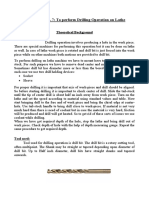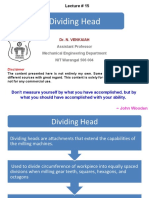Indexing
Indexing
Uploaded by
Muhammad Junaid ChohanCopyright:
Available Formats
Indexing
Indexing
Uploaded by
Muhammad Junaid ChohanCopyright
Available Formats
Share this document
Did you find this document useful?
Is this content inappropriate?
Copyright:
Available Formats
Indexing
Indexing
Uploaded by
Muhammad Junaid ChohanCopyright:
Available Formats
Manufacturing Processes-1 Lecture#6
Date: 18-10-2012
INDEXING
Definition: Indexing is an operation of dividing a periphery of a cylindrical workpiece into equal number of divisions by the help of index crank and index plate when milling gear teeth, squares, hexagons, and octagons. Also used to rotate workpiece at predetermined ratio to table feed rate
A manual indexing head includes a hand crank. Rotating the hand crank in turn rotates the spindle and therefore the work piece. The hand crank uses a worm gear drive to provide precise control of the rotation of the work. The work may be rotated and then locked into place before the cutter is applied, or it may be rotated during cutting depending on the type of machining being done. Most dividing heads operate at a 40:1 ratio; that is 40 turns of the hand crank generates 1 revolution of the spindle or work piece. In other words, 1 turn of the hand crank rotates the spindle by 9 degrees. Because the operator of the machine may want to rotate the part to an arbitrary angle indexing plates are used to ensure the part is accurately positioned . Types of Indexing: 1. 2. 3. 4. 5. Direct indexing: In direct indexing,the index plate is directly mounted on the dividing head spindle with a standard indexing plate having 24 holes all factors of 24 can be indexed i.e the work can be divided into 2,3,4,6,8,12, and 24 parts
1 10-ME-33,54,57
Direct Indexing Simple Indexing Compound Indexing Differential Indexing Angular Indexing
Manufacturing Processes-1 Lecture#6
Date: 18-10-2012
Simplest form of indexing Performed by disengaging worm shaft from worm wheel by means of eccentric device in dividing head, spring-loaded tongue lock engages numbered slots in index plate Used for quick indexing of workpiece when cutting flutes, hexagons, squares, etc.
Simple indexing: In simple or plain indexing,an indexed plate is fitted on the worm shaft and locked through a locking pin. A typical set has following number of holes. Plate 1: Plate 2: Plate 3: Compound indexing: When none of the indexed plate has a hole circle which would enable the work to be divided by simple indexing method we can use compound indexing. The procedure is explained below; Let; z = no. of division needed Crank rotations for each indexing= 40/z i. ii. iii. iv. Write z above and 40 below a straight line and factorized them Select 2 numbers representing 2 hole circles in the same plate. Write these numbers below 40 and factorized them. Write their difference above z and factorize it. These hole numbers are too be chosen in such a manner that all the factors above the line get cancelled out. Let these holes numbers be N1 and N2 Let n1 be the numbers of holes indexed in N1 hole circle and n2 the number of holes to be indexed in N2 hole circle. Then; n 1/N1 +/- n 2 /N2 = 40/z
2 10-ME-33,54,57
15,16,17,18,19,20 21,23,27,29,31,33 37,39,41,43,47,49
Manufacturing Processes-1 Lecture#6
Date: 18-10-2012
n1 and n2 are found by hit and trail method. Example Let z=77 Steps ; i. ii. 77=11x7 40=2 x 2 x 2 x 5 Let N1= 21 and N2 = 33 Difference 12= 2 x 2 x 3 Therefore 77 = 11 x 7 40 = 2 x 2 x 2 x 5 21 = 7 x 3 33 = 11 x 3 Since all the factors above the line get cancelled out, therefore, selection of N1 and N2 is correct. Now; n1 /21 +/- n 2/33 = 40/77 Values of n1 and n2 would be determined by hit and trail method. Differential indexing: Differential indexing in reality is an automatic method of doing compound indexing and is achieved in a single step. Used when 40/N cannot be reduced to a factor of one of the available hole circles. Index plate must be revolved either forward or backward part of a turn while index crank turned to attain proper spacing (indexing).
Procedure: Let z = no. of divisions required to be indexed k = number very nearly equals to z
3 10-ME-33,54,57
Manufacturing Processes-1 Lecture#6
Date: 18-10-2012
No. of crank turns for each simple indexing n = 40/k No. of crank turns needed for z indexing N = 40z/k i. ii. If N >40, then(N-40) turns have to be subtracted if N < 40 , then (40-N) turns indexed plate should rotate in same direction as of crank.
The gear ratio will be: I=40(k-z)/k Example : Do differential indexing for 93 divisions Solution; z = 93, therefore, Let k = 90, which can be simple indexed each indexing = 40/90 =4/9 =8/18, i.e., 8 holes in an 18 holes circle. For 93 indexings, N = 8/18 x 93 = 41 1/3 Since N>40, the indexed plate must rotate 4/3 backward I=40(k-z)/k= 40/90 x 3 =4/3 In brown and sharp dividing head, the gears supplied are 24,28,32,40,44,48,56,64,72,86,100 Angular Indexing: Angular indexing is used when it is necessary to cut grooves subtending a given angle at the center of the circle. Now 1 turn of crank = 9 of the spindle. Example: Calculate indexing for 60 60 2 Indexing 6 9 3 6 full turns plus 12 holes on 18 hole circle
4 10-ME-33,54,57
Manufacturing Processes-1 Lecture#6
Date: 18-10-2012
Example: Calculate indexing for 2430' First, convert angle into minutes (24 x 60') = 1440' now add 30' = 1470 Convert 9 to minutes 9x90 = 540 Divide 1470'/540' = 2 13/18
2 full turns and 13 holes on 18 hole circle
Therefore ; Turns of crank to give any angle = angle required/9. Example: Do angular indexing for 5137 Solution: Indexing = 51 37/9 =5 + 397/540 Let us convert the residual turn to a continued fraction, 397 ) 540 ( 1 397 143 ) 397 (2 286 111 ) 143 ( 1 111 32 ) 111 ( 3 96 15 ) 32 ( 2 30 2 ) 15 ( 7 14
5 10-ME-33,54,57
Manufacturing Processes-1 Lecture#6
Date: 18-10-2012
1)2(2 2/0 So we have, 1,2/3,3/4,11/15,25/34,186/253,397/540 Now select Those values of numerator and denominator which occur in 1,2,3 plates. So, 5 x 11/15 x 9 = 51 36 Difference of one minute occurs. (not acceptable) So now we have Cinnaciti and Parkinson 1- 24,25,28,30,34,37,38,39,41,42,43 2- 46,47,49,51,53,54,57,58,59,62,66 So 5 x 25/34 x 9 = 5137 3 11/16
Now it I acceptable because it has minimum difference of seconds.
6 10-ME-33,54,57
You might also like
- The Indexing or Dividing HeadDocument58 pagesThe Indexing or Dividing HeadC.E. Ishmeet SinghNo ratings yet
- MACHININGDocument10 pagesMACHININGDrSomnath BhattacharyaNo ratings yet
- IndexingDocument10 pagesIndexingsaddam hosen100% (1)
- Indexing in MillingDocument32 pagesIndexing in MillingDevarakonda Kondayya67% (3)
- Experiment No. 5: To Perform Threading Operation On LatheDocument5 pagesExperiment No. 5: To Perform Threading Operation On LatheHasnain Ashraf100% (1)
- Experiment No. 6: To Perform Knurling Operation On LatheDocument4 pagesExperiment No. 6: To Perform Knurling Operation On LatheHasnain Ashraf100% (1)
- UNIT-1 Locating and Clamping: S.Dharani KumarDocument86 pagesUNIT-1 Locating and Clamping: S.Dharani KumarSaivineeth Gampa100% (1)
- 2 Vernier Height GaugeDocument7 pages2 Vernier Height GaugedfghjkNo ratings yet
- Practical 7 Lathe MachineDocument5 pagesPractical 7 Lathe MachineTendayiBonzo100% (9)
- Machining Time CalculationDocument7 pagesMachining Time Calculationdellibabu50988% (8)
- Taper Turning by Taper Attachment MethodDocument4 pagesTaper Turning by Taper Attachment MethodZia JanNo ratings yet
- Manual Part ProgrammingDocument38 pagesManual Part ProgrammingHot Shot100% (1)
- IndexingDocument25 pagesIndexingJaymin PatelNo ratings yet
- Man Pro Lab Exp No. 7 Working Principle of A Shaper MachineDocument8 pagesMan Pro Lab Exp No. 7 Working Principle of A Shaper Machinefotick100% (1)
- 1.tool Makers MicroscopeDocument7 pages1.tool Makers MicroscopeelavarasanNo ratings yet
- Lathe Feeding and Apron MechanismDocument22 pagesLathe Feeding and Apron Mechanismadhees100% (2)
- Experiment No. 3: To Perform Turning Operation On LatheDocument3 pagesExperiment No. 3: To Perform Turning Operation On LatheHasnain AshrafNo ratings yet
- Experiment No. 2: To Perform Facing Operation On LatheDocument3 pagesExperiment No. 2: To Perform Facing Operation On LatheHasnain Ashraf100% (3)
- Broaching (1)Document16 pagesBroaching (1)patel ketan82% (11)
- Practical No 8Document14 pagesPractical No 8kaushal2442No ratings yet
- Boring MachineDocument38 pagesBoring Machinemitmandsaur67% (3)
- 2D - TransformationDocument95 pages2D - TransformationShubhamNo ratings yet
- Machining Process Lab ReportDocument31 pagesMachining Process Lab ReportHafiz Hamza83% (12)
- NC & CNC MachinesDocument12 pagesNC & CNC MachinesRenjith Rajendraprasad100% (1)
- Production Engg Lab Manual (V Semester) Lathe Tool DynamometerDocument4 pagesProduction Engg Lab Manual (V Semester) Lathe Tool Dynamometerpsmonu54No ratings yet
- Unit 1 - Gear Manufacturing ProcessDocument54 pagesUnit 1 - Gear Manufacturing ProcessAkash Divate100% (1)
- Classification of CNC MachineDocument11 pagesClassification of CNC Machineaqtu12fuc81% (16)
- 50 Questions and Answer: Milling Machine (Milling Machine) Is A Machine Tool That Is in The ProcessDocument4 pages50 Questions and Answer: Milling Machine (Milling Machine) Is A Machine Tool That Is in The ProcessZul FakriNo ratings yet
- Orthogonal & Oblique CuttingDocument2 pagesOrthogonal & Oblique CuttingShivanshu shekhar100% (3)
- Computer Aided Part ProgrammingDocument19 pagesComputer Aided Part ProgrammingPiyush Aggarwal100% (4)
- Difference Between Centre Lathe and (Capstan or Turret) LatheDocument1 pageDifference Between Centre Lathe and (Capstan or Turret) Lathevenkateshyadav2116No ratings yet
- Spur Gear Cutting On Universal Milling MachineDocument8 pagesSpur Gear Cutting On Universal Milling MachineMurali SiddarthNo ratings yet
- Drilling Machine Operations & ClassificationsDocument23 pagesDrilling Machine Operations & Classificationsmuneiah100% (1)
- Milling MachineDocument13 pagesMilling Machinevndeshmukh94% (35)
- Shaper MachineDocument4 pagesShaper MachineJaydeep Sakariya60% (5)
- Experiment No. 7: To Perform Drilling Operation On LatheDocument3 pagesExperiment No. 7: To Perform Drilling Operation On LatheHasnain Ashraf100% (2)
- Classification of NCDocument9 pagesClassification of NCAmarnadh60% (5)
- Machine Shop Workshop TechnologyDocument11 pagesMachine Shop Workshop TechnologyVijayaragavan Sakthivel75% (4)
- Study of Milling MachineDocument7 pagesStudy of Milling Machineসুবোধ বালক0% (1)
- Lecture Notes On CNCDocument125 pagesLecture Notes On CNCniteen_mulmule48580% (5)
- Boring MachineDocument49 pagesBoring MachineRohit Ghulanavar100% (3)
- Grinding and Grinding OperationsDocument14 pagesGrinding and Grinding OperationsRitik Pothare0% (2)
- NPL Flatness InterferometerDocument6 pagesNPL Flatness InterferometerMoula Moulali100% (1)
- Design of Gear BoxesDocument19 pagesDesign of Gear BoxesMuthuvel MNo ratings yet
- Module 5 TOOLING and WORK HOLDING DEVICESDocument17 pagesModule 5 TOOLING and WORK HOLDING DEVICESsiddharth100% (1)
- Taper Turning PDFDocument10 pagesTaper Turning PDFMaria Mehar0% (1)
- Grinding Lab ManualDocument4 pagesGrinding Lab ManualArun kumar rouniyar100% (1)
- Kinematics of Machine ToolsDocument28 pagesKinematics of Machine ToolsRohit Kaushik100% (6)
- Workshop Practice IIDocument50 pagesWorkshop Practice IIFikremariam Ermias100% (3)
- CNC MillingDocument8 pagesCNC MillingNashon MutuaNo ratings yet
- Exam Paper On Design of Machine ToolsDocument8 pagesExam Paper On Design of Machine ToolsCharles Ondieki100% (2)
- Experiment On FittingDocument8 pagesExperiment On FittingZatchBell100% (1)
- Manufacturing Process 1 Question BankDocument6 pagesManufacturing Process 1 Question BankAshok Pradhan100% (1)
- LAB REPORT of Gear Hobbing MachineDocument6 pagesLAB REPORT of Gear Hobbing MachineAhtisham AmjadNo ratings yet
- Lab Report of Drill MachineDocument6 pagesLab Report of Drill MachineAhtisham AmjadNo ratings yet
- Differentiate Between Line Standard and End Standard of Measurement 1Document19 pagesDifferentiate Between Line Standard and End Standard of Measurement 1ghghgNo ratings yet
- Use of Dividing HeadDocument20 pagesUse of Dividing Headajs_pto3117No ratings yet
- Indexing - Fdup 20 21Document39 pagesIndexing - Fdup 20 21AHMAD MUSANo ratings yet
- 02 Dividing HeadDocument22 pages02 Dividing HeadMohit KumarNo ratings yet
- Indexing HeadDocument3 pagesIndexing HeadAnwar ArifNo ratings yet



























































